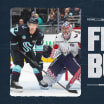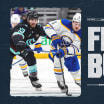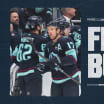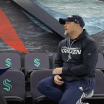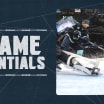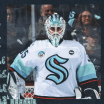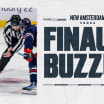Shawn Schneider knows there are only so many dreams your average recreational league netminder truly wants coming true when it involves suiting up for an NHL game.
As a Climate Pledge Arena designated Emergency Backup Goaltender, or EBUG as commonly referred to, Schneider has not yet been needed to even come down from the stands to suit up for a No. 2 netminding role on the bench. Never mind getting into an actual game, which has only happened a handful of times since the NHL mandated back in 2016-17 that teams keep an emergency third goalie on hand at arenas for every game.
“I think the odds of going in are so low," Schneider, 26, recently told Brianna Vasquez, who produced a feature on EBUGs for the weekly Kraken Home Ice show on KING 5 TV. "I'm not really too worried about it. But then a play will happen, and the goalie will stay down on the ice and I'm like, my heart starts racing. I'm like, ‘Oh, is it happening? Is it happening?’ And then they get up, and I'm like, ‘Oh. Sigh of relief.’ ”
Indeed, the scenario of a beer-league netminding equivalent being pulled from the stands and playing in an NHL game might seem like something out of a Hollywood movie for fans to rejoice in. But teams forced to use an EBUG on-ice and often the goalies themselves usually pray it never happens, lest an impossible NHL dream turn into an embarrassing nightmare.
The Kraken nearly had such a scenario unfold while on the road last month, when projected starting goalie Joey Daccord came down with food poisoning overnight ahead of an afternoon game against the New York Rangers.
Rather than use an actual EBUG as Philipp Grubauer’s backup that day, the Kraken put a call into Michael Matyas – a former college netminder a decade ago who happened to live across the river from Manhattan in suburban New Jersey. Matyas had known Kraken team services director Brennan Baxandall since their youth playing days in Calgary, Alberta and agreed to sign a one-day, unpaid amateur tryout contract to sit on the team’s bench as a backup at Madison Square Garden.
But things took an unexpected turn when Grubauer got hit in the head by an opposing player midway through the opening period and lay on the ice for several long moments. It seemed certain Matyas would actually have to play in the game until Grubauer rallied, shook off his apparent injury and helped the Kraken to victory.
Matyas technically was not an EBUG, though he might as well have been one, given his last serious competition was for the University of Alaska Anchorage back in 2014-15, and he now works in financial services.
Rules surrounding actual EBUGs are quite specific. They can’t be under any type of professional goalie services contract, though teams prefer they have experience at the pro, college or at least high school level.
Each NHL team must pay one EBUG in the stands at every home game and have them be available to either team if a goalie goes down. The Kraken keep a rotation of three such emergency goalies, paying them an hourly minimum for their time in the stands, plus two free tickets to the game and a parking pass.
The emergency backups also can’t be paid team employees, owing to the fact they could be called on to face that team if the visiting squad needs them.
Before the EBUG rule, team personnel would typically don goalie pads in an emergency.
“A lot of people don't know that it's a thing,” Schneider told Kraken Home Ice of an EBUG setup unique in pro sports. “So, when you try to explain it to them, it doesn't sound real like you get paid to go watch the game, and if the goalies get hurt, you play.”
Schneider is from the Buffalo area and played for an 18-under Junior Sabres team for two seasons, then three more years for the club-level team at Clarkson University through the 2019-20 season. His introduction to EBUG life came out of the blue.
“My story is kind of unique in this regard because I was living in Buffalo and I was sitting at the table eating dinner with my parents on a random Saturday night," Schneider said on the KING 5 show. "And I get a call from the Buffalo Sabres and they asked, hey, are you available to be the emergency backup goalie? And I'm like, ‘Am I available to be the emergency backup goalie? Yeah.’ I was like, 'Dad, we're going to the Sabres game.' "
Watching the Sabres and these days, the Kraken from the stands is as close as Schneider has gotten to the ice or even the bench.
But on Feb. 22, 2020, the Carolina Hurricanes were forced to use David Ayres, a 42-year-old Zamboni driver for the Maple Leafs’ AHL team, as their goalie midway through a game in Toronto. Regular Hurricanes goalies James Reimer and Petr Mrazek were both injured during the contest and as the arena’s designated EBUG that night, Ayres was next in line for the visiting team.
He promptly allowed two goals on the first shots he faced, then settled in and stopped eight in a row in a 6-3 victory.
Ayres remains the only EBUG credited with an actual win as the goalie of record, though others have been used since the rule was created – most recently last season when University of Alberta netminder Matt Berlin saved his only shot faced in finishing the final 2:26 of a 7-3 victory by the Edmonton Oilers.
Back in 2018, accountant Scott Foster played the final 14 minutes of a 6-3 win for Chicago.
Tyler Zetting, 35, now a Kraken senior director of finance, served as one of the team’s EBUGs during the 2021-22 inaugural season. Though he sat in the stands for what he estimates as 13-15 games, he never actually got called down to the bench due to a goalie injury.
But if he had, or – heaven forbid – was forced to actually play, Zetting insists he would have relished the opportunity.
“I was always excited in a way for it to happen,” said Zetting, a former Western Washington University club-level goalie who stopped being an EBUG when hired to his current Kraken role. “Almost in a surreal way. But I was never scared.”
Zetting has also had chances to practice with the Kraken and took part in a 3-on-3 game as part of the Kraken Super Skills Showcase at Climate Pledge back in November. In other words, he’s faced shots taken by NHL players before.
“I know the guys pretty well now and I know how they can rally around and support a goalie,” Zetting said. “I just approach it as take in the experience and try not to get overwhelmed by the stage.”
One-day Kraken backup netminder Matyas had tried to avoid being overwhelmed on the bench at Madison Square Garden last month as he watched Grubauer lying motionless on the ice. At one point, Kraken defenseman Adam Larsson skated over to Matyas on the bench and told him he hoped he was ready.
“I would have given it my all,” Matyas told the Seattle Times, admitting his blood was pumping and heart racing.
Current Kraken EBUG Schneider has gotten to practice with the Kraken a couple of times when they’ve needed extra goalies, which he hopes would have him mentally ready for an emergency NHL game insertion scenario. He’s played mostly a skater role in his rec-league games since moving to Seattle, but tends goal every now and then just to stay fresh between the pipes.
“It's getting paid to watch hockey, and then worst comes to worst, you have to go and play in the game, which is really best comes to best," Schneider said. "I mean, hopefully, your goalies aren't getting hurt.”



